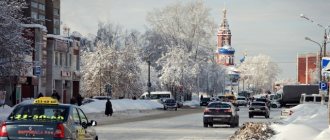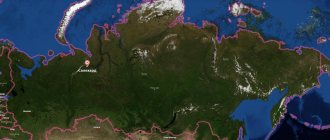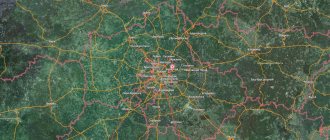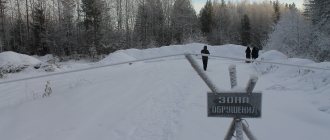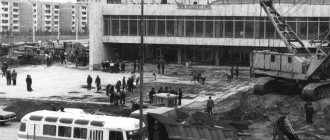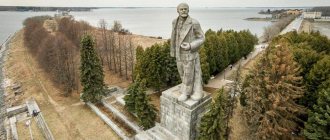Novy Urengoy is the largest settlement in the Yamal-Nenets Autonomous Okrug. Surprisingly, in size it surpassed even the capital of the district, Salekhard. On the satellite map of Novy Urengoy you can see that the city is located on the banks of the Evoyakha River, and two more waterways - Tamchara-Yakha and Sede-Yakha, divide it into 2 parts. The city is located only 60 km from the border with the Arctic Circle, so in the summer it is always light at night.
The appearance of the settlement is associated with the development and production of gas. On the territory of the modern city, which can be seen in detail on the map of Novy Urengoy with diagrams, in the middle of the last century there was one of the Gulag camps. The barracks of the abandoned camp were occupied by geologists and seismic surveyors in 1966 to conduct research into the subsoil of this territory. A gas field was found, and a city of gas workers began to be built on the site of the camp.
The construction of the city was greatly facilitated by the railway built long before by Gulag prisoners, which is reflected on the map of Novy Urengoy by district. In fact, the first houses for natural gas producers began to appear near the railway station.
Geographical location and history of Novy Urengoy
The city of Novy Urengoy is the unofficial gas capital of Russia, a city of gas workers, construction workers, unforgettable white nights and simply beloved Nur, so affectionately nicknamed by local residents.
A city where white nights reign in summer, and gray snow reigns in winter... It is not surprising that throughout the summer it is as light at night as during the day. After all, Novy Urengoy is located in the northern part of Western Siberia, only 60 km south of the Arctic Circle on the coast of the Evoyakha River, a tributary of the Pura. And it seems that the very existence of Urengoy is also inextricably linked with rivers - two small rivers flow through the city - Tamchara-Yakha and Sede-Yakha, dividing its territory into two large regions - Northern and Southern.
And the name of the city “Urengoy” is due to the combination of the Khanty and Nenets words “Ure” and “Ngo”, meaning “oxbow lake” and “island” or an island on the site of the old river bed.
Some sources interpret the translation of the word “Urengoy” as “bald hill” or “hill covered with yellow grass,” but earlier the name of the city was translated as “a lost place,” so nicknamed by Gulag prisoners. Actually, it was from the Gulag that the history of the city began back in 1949, when, near New Urengoy, its prisoners, on the orders of Stalin, began to build the Salekhard-Igarka railway, which after his death was declared economically unfeasible, the work was curtailed, and the road was nicknamed “dead.”
Only years later, employees of the Tsibenko seismic station would borrow one of the Gulag camps as a base, and later discover the first gas field, later named Urengoyskoye. So in June 1966, in Urengoy, the team of master Polupanov would cut the first exploration well, and a new Urengoy natural gas field would appear on the geological map of the USSR - the largest in the world in terms of hydrocarbon production.
However, active development of the city will begin only in 1973, when the first convoy arrives from the village of Pangody to the site of the future settlement in order to begin construction of the city. In 1975, Novy Urengoy was registered as a village, and already in 1978, Urengoygazdobycha emerged - the largest production association, which reached the production of the first billion cubic meters of Urengoy gas by May 30 of the same year. Just two years later, in 1980, Novy Urengoy received the status of a city, and already in 1983, through the constructed Urengoy-Pomary-Uzhgorod gas pipeline, Urengoy gas began to flow to Western European countries.
After which the city continues to develop at a rapid pace and soon surpasses the administrative capital of the Yamal-Nenets Autonomous Okrug, Salekhard, in economic indicators and population, becoming the second largest city in the district and second only to Noyabrsk. Today, about 550 billion cubic meters of natural gas are produced annually in Yamal, where the leading role belongs to the enterprises of Novy Urengoy, and the city itself is among the top ten in terms of per capita income in the Russian Federation.
One of the cities of Western Siberia: general information
The city of Novy Urengoy - what region does it belong to? To Tyumen, which, in turn, is a constituent unit of the Yamalo-Nenets Autonomous Okrug. The city of Novy Urengoy is the largest populated area in the district and one of the few that is ahead of the administrative center of its subject both in industrial potential and in population (we are talking about comparison with Salekhard). The city discussed in this article is 450 kilometers east of the latter; It is separated from Moscow, located in the northeast of the capital, by 2,350 kilometers. In addition, residents of the city of Novy Urengoy, unlike Muscovites, live in a different time zone: for example, the New Year and other holidays are traditionally celebrated 2 hours earlier. Today the city is home to about 116 thousand people. Being a key link in the largest gas-bearing region, Novy Urengoy, the location map of which will be presented below, is unofficially called the gas-producing capital of the country.
“I came out of the forest; there was a severe frost" or all about the climate and ecology of Novy Urengoy
However, this “income” is not so easy for the residents of Novy Urengoy, who live in harsh climatic conditions, as evidenced even by the entries in their work books - “Region of the Far North”. Despite the fact that Novy Urengoy is located in the temperate continental climate zone, the city’s territory falls on its northernmost part, bordering on a subarctic climate, and therefore the weather conditions here are appropriate. The average annual air temperature in the city fluctuates between – 5.7°C, and the average annual humidity is 78%.
Winters in Urengoy are long and cold (about 284 days a year) and, as in Nekrasov’s poem, are characterized by “severe frosts.” The lowest temperatures occur in January and February. And although the monthly averages for these months are -21.7 and -20.1°C, during this period the thermometer often drops below -30°C, often remaining at -45°C.
During periods of such severe cold weather, schoolchildren are announced on all local TV channels forced holidays - “aktiki”, and on days of particularly severe frosts, even some organizations are closed. Just as hard as the severe cold, local residents endure during the winter season is the short duration of daylight hours, averaging 1.5-2 hours, while on the shortest day of the year - the winter solstice - the sun appears in Novy Urengoy and only for 1 hour and 5 minutes.
But the main attraction of summer in the city, as opposed to winter, are the white nights, lasting from June to August, and the warmest period occurs in July with average monthly temperatures of +15.1°C. Despite the fact that summer in the city lasts only about 35 days, often at this time in Novy Urengoy there is suffocating heat of about +25..+30°C.
The amount of precipitation that falls during the year is quite insignificant and amounts to no more than 400 mm. Another characteristic feature of the city is strong winds (10-15 m/sec, or even higher) and sudden temperature changes, during which thermometers can change their readings by 15-20°C during the day.
But the environmental situation in the city, despite its “gas-producing status,” is characterized by enviable stability. The main industrial enterprises of Novy Urengoy are located far beyond the city limits, in its so-called industrial zone, household waste, along with snow in winter, is regularly removed, and any unauthorized landfills in Novy Urengoy are immediately punishable by huge fines. In 2010, a workshop for recycling mercury-containing lamps, including fluorescent lamps, was also opened in Nura.
The “multinational” face of Urengoy residents – features of the city’s population
Harsh natural conditions could not but affect the demographic characteristics of New Urengoy. And, despite the fact that the gas capital is the second most populous city in the Yamal-Nenets Autonomous Okrug, according to 2012 data, only 106 thousand people live in Novy Urengoy. However, for the conditions of the Far North, this is practically a record, especially considering the fact that in 1979 the number of Urengoy residents did not even reach the ten thousand mark, amounting to only 8,580 people.
But the development of the city proceeded at a rapid pace. After the opening of Urengoygazdobycha, the need for labor resources increased every year, an increasing number of people working in gas and engineering and construction specialties came to the city, and by 1989 more than 93 thousand people lived in Nura. It is after this point that the population begins to grow, mainly not due to incoming labor resources, but naturally due to the birth rate. In 2002, the number of Urengoy residents reached 94.5 thousand people, and statistics at the beginning of 2014 already indicate 115.8 thousand city residents.
It is not for nothing that Novy Urengoy is called the city of the future and youth. The demographic situation of Nur is characterized by enviable stability and with a birth rate of about 14 people per 1000 Urengoy residents (2011), today the number of its residents under the age of 18 is more than 25% of the total population of the city.
The working population of Urengoy is also large (over 60% of the total), which is primarily due to the fact that after retirement, most Urengoy residents move for permanent residence to the central regions of the country on their own or under a local resettlement program. The majority of the working population consists of workers at gas production enterprises with narrow technical specialties, engineers, builders and service workers.
Another typical feature of the population of the unofficial gas capital is its multinationality. Today, representatives of more than 40 nationalities live in Novy Urengoy, most of whom are Russians, Ukrainians, Tatars, Chechens and Dagestanis, Circassians, as well as other people from the southern Russian republics, including countries of the post-Soviet space. Based on this, the city’s believing population is divided into two main groups: Christians (the vast majority) and Muslims.
New Urengoy Airport
In the city of Novy Urengoy there is an airport with one runway and artificial turf. The distance from the city center to the airport is 5 km to the southwest. Airfield type: civil. The airport is open every day from 1:30 to 13:30.
Novy Urengoy Airport serves aircraft of major Russian airlines: UTair, Aeroflot, Yamal, S7 Airlines, Gazpromavia. Popular destinations of regular and charter flights: Moscow, Ufa, St. Petersburg, Yekaterinburg, Krasnoyarsk. The annual passenger traffic is more than 900 thousand people.
Districts and real estate of New Urengoy
But territorially, according to official documentation, the city of Novy Urengoy is divided into four large districts: northern and southern, as well as the districts of Limbayakha and Korotchaevo. The first two districts, popularly called “Severka” and “Yuzhka”, actually represent the city itself and are separated by a tundra zone and two rivers.
But the districts of Limbayakha and Korotchaevo are more than 70 km away from the center of New Urengoy, and until 2004 they were autonomous administrative-territorial units. However, in September 2004, a referendum was held among the population of these villages on the desire of the residents to become part of the city of Novy Urengoy, as a result of which, by a majority of votes, it was decided to transform the villages of Limbayakha and Korotchaevo into areas of the “gas capital”. Thus, Novy Urengoy acquired two districts significantly removed from its center and became one of the longest cities in the world with a total length of more than 80 km.
However, the Urengoy residents themselves still consider Korotchaevo and Limbayakha to be separate villages, and their two inextricably linked parts, the northern and the southern, are considered districts of the city.
Yuzhka, as a district of New Urengoy, is the oldest part of the city, from which the history of the emergence and development of Urengoy actually began. It was here on September 23, 1973, on the site of the future city, under the famous words of the Minister of Gas Industry Sabit Orujov: “Here will be the city of gas workers and builders Urengoy,” a symbolic peg was driven into the ground.
Today, the southern part of the city is the location of most administrative and public institutions. The main places of “meeting and parting” in the city are located here - the railway station and the airport,
and the main points of “treatment and rehabilitation” of New Urengoy - the Municipal City Hospital and the largest private medical clinic “Scanner”, as well as the “favorite authorities” of entrepreneurs, accountants and the rest of the working population of the city - pension, social insurance and tax services.
Geographically, the south also owns the migration service, the registry office, the Ministry of Internal Affairs and the traffic police, a mosque and an Orthodox church under construction. Actually, the main city-forming and largest gas industry enterprises are concentrated in the southern part of the city. These are Gazprom Dobycha Urengoy and Gazprom Dobycha Yamburg, as well as Burgaz, Rospan International, Rosneftegaz, etc.
But the “conventional center” of the southern part of New Urengoy is occupied by the Cultural and Sports Square and the main square of the city, where all the most significant events of the “gas capital” take place. Not far from the square is the picturesque Nameless Lake, surrounded by a small park. In summer, seasonal cafes operate along its shores, and in winter, you can ride on a snowmobile or a reindeer sleigh on the frozen lake (during the holiday of the Northern Peoples).
Although, unlike the northern part of New Urengoy, the fabric of the south is mostly woven from parallel and intersecting streets (central Leningradsky Prospekt, Sibirskaya Street, Geologorazvedchikov, 26 Congress of the CPSU, etc.), and not from the usual microdistricts, the location of residential buildings is here also distinguished by its “northern compactness”.
And each “mini-group” of residential high-rise buildings certainly has its own school, kindergarten, pharmacy and supermarket (shopping center) or several grocery stores.
And in order to become the owner of an apartment in one of these residential areas of New Urengoy, you will have to pay a tidy sum. Thus, according to average estimates, the cost of one-room apartments in the southern part of the city today on the secondary market is about 3.2-3.5 million rubles (depending on the condition of the housing, square footage, number of floors, distance from the bus stop, etc.).
Housing in wooden houses, the so-called KDMO, is much cheaper, and there are fewer and fewer of them in Novy Urengoy every year. So, on average, a one-room apartment in such a building can cost a potential buyer 2 million rubles. But since such real estate is often sold even without a warrant (at prices of 100-300 thousand rubles), there are very few, if not very few, people willing to purchase it.
Urengoy residents are also in no hurry to buy up the newfangled townhouses that have recently sprung up like mushrooms on the outskirts of the southern part of the city. And although their prices are not much higher than the prices for housing in apartment buildings, not everyone dares to buy a private house built on permafrost territory.
Housing in the northern part of the city, which was developed later than the southern part and is rightfully considered its residential area, is no less expensive, if not more. Well, since most of the houses here are newer than in the south, the cost of one-room apartments ranges from 3.2-3.7 million rubles (resale), and the residential buildings themselves are located in the city’s neighborhoods adjacent to each other: Druzhba, Mirny, Yubileiny , Soviet, Eastern and Student.
As in the south, almost every district has complete infrastructure - its own school, kindergarten, pharmacy and a number of shops or even a shopping center. By the way, all residential buildings in the city are maintained by management companies and the administration in good, often excellent condition: every spring, snow and ice are cleared from the roofs, and the facades of the most “dilapidated” houses are re-plastered, repainted, and sometimes even re-clad.
In the northern part of New Urengoy there are much fewer administrative and public buildings than in the southern part. The city administration and departments of the clinic and passport office are located here. Among the city-forming enterprises in the north, one can name the Gazprom Dobycha Urengoy branch. But the real decorations of the north are rightfully considered its temple, “campus” and park.
Beyond the outskirts of the Druzhba microdistrict, on the picturesque coast of the Sede-Yakha River, the wooden temple of St. Seraphim of Sarov rises majestically.
Just a few minutes walk from it there is a young park with a unique summer fountain. Well, in the very “heart” of the northern part of the city there is a student town with the Novy Urengoy Technical School of the Gas Industry and the square with the Victory Monument located in front of it.
Infrastructure of Nur - a paradise in three dimensions
As they say, we won’t take it with one, but with the other. And if the natural conditions of the city, with their harshness, are not conducive to a joyful stay in it, then the infrastructure of New Urengoy, on the contrary, is thought out to the smallest detail for the joy and convenience of local residents. Moreover, this can be said with confidence both about transport and about the industrial and social infrastructure of Nura - a kind of paradise in three dimensions.
Thus, Novy Urengoy can safely boast of 100% availability of all means of transportation. At the same time, air transport has always been and remains the most popular in the city. Today, the local airport receives aircraft from Moscow (3-5 flights daily), the northern capital - St. Petersburg (at least a flight per week), as well as Tyumen, Yekaterinburg, Samara, Salekhard, etc. During the “warm period”, seasonal flights operate between Novy Urengoy and Krasnodar, as well as Nur and Mineralnye Vody.
No less developed in the gas capital is the railway service, represented mainly by Russian Railways trains. So, a train departs from Urengoy to Moscow every day; according to this message, the train also runs on schedule. In addition, trains depart from the Urengoy station to Tyumen, Yekaterinburg, Kazan, etc., and the railway connection itself plays an important role in freight turnover. The local river port, located in Korotchaevo and being a transport artery between the cities and towns of the Yamal-Nenets Autonomous Okrug and the Northern Sea Route, also plays an equally important role in the city’s economy. The Urengoy River Port bears the lion's share of cargo delivery for local construction and gas production enterprises.
The city's transport network is also very developed: in addition to the main roads crossing the territory of Nur, the city has bypass routes, and in its southern part a local viaduct was built for optimal transport interchange.
That is why there are practically no traffic jams in Novy Urengoy, with the exception of a slight congestion of the highway in the morning hours (from 7 to 9 am), and the main ones are caused either by accidents on the roads or by the “slipping” of freight trains under the viaduct. The road surface in the city itself is of high quality; moreover, in “problem areas”, repair work is carried out every summer and new asphalt is laid. In recent years, a tradition has emerged every summer to expand the highway in some area of Urengoy.
In addition, due to the city’s low supply of garages, the Urengoy administration annually increases the area of “parking spaces” near houses by increasing the driveways in front of them.
As mentioned earlier, housing and communal services are not lagging behind: the areas adjacent to houses, as well as the entrances to them, are regularly cleaned by Urengoyzhilservice employees, and in winter they are cleared of snow. Actually, this diligence is partly caused by the high prices for utilities in Nura, where, for example, 1 cubic meter of hot water costs Urengoy residents on average 104 rubles, cold water - 28 rubles, with the cost of a cubic meter of sewerage being 31 rubles. And the very “maintenance” of housing, for example, a small one-room apartment, will cost about 1,400 rubles per month; a slightly smaller amount, about 1,150 rubles, will have to be paid for its monthly heat supply. At the same time, the cost of 1 thousand cubic meters of natural gas costs Urengoy residents 2,686 rubles, which is only 27 rubles per month for the maintenance of one stove. Average prices for electricity in the city are 1.7 rubles per 1 kWh.
Social infrastructure is also very developed in Novy Urengoy. There are more than 38 preschool institutions, 24 schools in the city, including a local gymnasium, a secondary evening school and 2 elementary schools. The doors of the local school are open for children with developmental disabilities, and Urengoy youth can receive secondary vocational education in a number of local schools, including the gas industry technical school. In addition, 7 branches of Russian universities have been opened in the city, the most important among which is the Yamal Oil and Gas Institute.
Nur's healthcare sector is represented by 11 medical institutions, with the largest of them being the municipal city multidisciplinary hospital. In addition, the gas capital has 17 sports institutions, as well as a number of city palaces and cultural and sports centers.
Industry
Novy Urengoy, being a fairly young city, manages to demonstrate extraordinary industrial potential. Thus, within the settlement there are 3 pillars of the gas production industry, each of which is a subsidiary: Tyumenburgaz, Yamburggazodobycha and Urengoygazprom. They account for about 74% of all gas produced in the country! Construction work to restore railway lines is being carried out by the Yamal Railway Company. 80% of river transportation occurs at the Urengoy river port, which has dozens of ferries and tractors.
Deserved status of the gas capital - enterprises and work in Novy Urengoy
In fact, Novy Urengoy received the unofficial status of the “gas capital” of Russia quite deservedly, because the leading role in the economic complex of the city belongs to the gas industry. Thus, the city-forming enterprises of Nur are such global industrial giants as Gazprom Dobycha Urengoy, Gazprom Dobycha Yamburg, a branch of Urengoy Drilling, Gazprom Podzemremont Urengoy, as well as other large enterprises such as Rospan International, " Arcticgaz", "Achimgaz", "Rosneftegaz", etc., which own more than 74% of all gas production in the Russian Federation.
It is worth noting that the fuel and energy industry of the city employs more than 80% of the city’s labor resources. At the same time, the main players in the fuel sector are Urengoygazprom, Yamburggazdobycha, Burgaz, Sibneftegaz, etc., while in the foreground in the electric power industry are Tyumenenergo, Urengoyskaya GRES, Mobile Power Stations Urengoy. and “Mobile Energy”.
Second fiddle after the fuel and energy complex in the economy of New Urengoy is played by the food industry, represented by a number of enterprises producing fish, meat and sausage, smoke-dried and dairy products, as well as various semi-finished products and bakery products. The actual production of confectionery and bakery products makes up a large part of the food industry in New Urengoy. And here it is impossible not to mention such leaders as the branch of Zapsibgaztorg - Urengoygaztorg, Yamal-plus, Ankor, Topaz and Revansh.
In the gas capital, the Novy Urengoy Water and Clean Water enterprises also produce soft drinks and drinking water, and the Assortment and Urengoygazdorstroymaterialy organizations supply local beer to the city’s shelves. In addition, about 400 retail trade enterprises, 6 food, mixed and clothing markets, as well as 36 public catering organizations and about 13 consumer services enterprises supply city residents with industrial and food products.
In recent years, namely a decade, several large shopping centers and entertainment complexes have been built in the city.
These include the Helicopter and Hudson shopping centers, which belong to the same owners and are essentially one chain based on the Anchor grocery supermarket, which is also represented in the city and in other shopping centers, for example, in the Yamal shopping and entertainment complex. .
But the pioneers include the Urengoygaztorg retail chain, whose products are presented in the large shopping centers “Siberia”, “Victoria”, “White Nights” and “Desyatochka”.
There are also chains of supermarkets for household chemicals and cosmetics in the city, such as Optima and Lyubimy, Letual, as well as large furniture stores and electronics supermarkets, including M-Video and Expert. Pharmacy chains in Novy Urengoy are represented by pharmacies “Rigla”, “Scanner”, “Health of the North”, etc.
In recent years, incredible competition has also flared up in the field of “fashion and beauty” - more than 10 beauty salons, hairdressers and ateliers have been opened in the city, as well as in the provision of legal and accounting services. The banking sector is dominated by two Russian giants - Sberbank, Gazprombank - and several largest Siberian banks Zapsibkombank, Sibneftebank, Khanty-Mansiysk Bank, etc. And all of the above for only 106 thousand inhabitants, which indicates high economic development of the city.
But the sphere of information support in Novy Urengoy is occupied by four print media and a similar number of local television and radio companies.
Criminal Novy Urengoy – gangster 90s and “clan” 2000s
By the way, a considerable share of the latter’s broadcasting is occupied by local crime reports. And if in the fateful 90s they were mainly devoted to local gang wars on the topic of “redividing an already divided world,” as well as reports about growing drug addiction, including children’s, then in the last decade, more and more often, reports about resonant conflicts based on interethnic strife. And the main participants in them are representatives of local southern diasporas, for example, the Chechen one, and “clanism” in Urengoy still remains one of the main problems of the local police.
So in 2008, during a birthday celebration, which was attended by about 10 people of Slavic nationality, a group of Caucasians of about 40 people suddenly appeared at the celebration, who subsequently started a fight using knives and shooting. As it turned out, one of the guys present at the birthday party had previously had a conflict with them, which the Caucasians decided to “resolve” at the time of their arrival. The result of the fight was the murder of a young man, Alexander Stakhov, and two more guys with knife wounds were urgently hospitalized in a local hospital.
After this incident, there were several more interethnic conflicts in the city, ending in fights and shootings. That is why later in Novy Urengoy, additional round-the-clock patrols of Nur were introduced to help the police in order to strengthen control over the criminal situation in the city.
At the beginning of 2012, steps were also taken to “close” Novy Urengoy as a city of industrial importance, to which visitors could only enter strictly by invitation or challenge. At the entrance to the city, “border” posts were set up, and inspection at the airport was supplemented by passport control. However, this practice did not last long and once again, for about the tenth time, the so-called “closure” of the city was a fiasco.
Urengoy tourist
In fact, ordinary guests of the city, tourists, as well as people coming to Urengoy on business visits, for whom the closure of the gas capital meant, first of all, paperwork, could not help but rejoice at this fiasco. Today they can freely visit the city, because, despite its obvious “youth” for the city, Novy Urengoy can safely boast of the presence of many local attractions.
Guests of the city should first of all visit the local stela of New Urengoy - a symbolic monument to the gas capital, located at the entrance to the city. And of course, cross the “invisible” line - the border of the Arctic Circle, on which a unique metal monument in the form of a sphere is installed.
Also in the city you can see a themed Victory memorial, where flowers are laid on each anniversary,
get acquainted with the pedestal “Pioneers of the development of Urengoy”, located in front of one of the divisions of Urengoygazprom,
visit the local city museum of fine arts and simply relax in the green park area “Druzhba” with its luxurious sail fountain.
Nature lovers can also visit Nameless Lake, which borders a small residential area in the southern part of the city.
and, of course, travel through the local picturesque tundra, so rich in the most diverse gifts of nature: mushrooms, berries and the most delicious northern fish.
Well, for those guests who love to eat deliciously, dance and relax in style, there are dozens of Urengoy cafes, restaurants and night clubs. The restaurants “Old Castle”, “Banker”, “Polar Owl” and “Lyon” are distinguished by their special sophistication, but a stay in them may seem somewhat expensive to guests who are not accustomed to “northern” prices. Thus, a table at the Banker club will cost its visitors about 4,000 rubles: payment for tables in this club is required, and for this amount you can order about two servings of excellent shish kebab, a side dish, a couple of salads and light cocktails.
The Madagascar cafe and a number of cafes and eateries in the Hudson, Helicopter and Siberia shopping centers have more affordable prices. Here you can simply chat with friends over a cup of aromatic coffee with cinnamon and taste excellent cottage cheese pie. But the famous McDonald's is not in the city yet, but it is being successfully replaced by a cafe with a similar menu - “In Great Demand”. In the city you can relax in two bowling clubs in “Polar Owl” and “Yamal”, and lovers of active recreation can play paintball and conquer the local skald.
In winter, you can ride snowmobiles and admire the local ice town, which is built every year on the main square by genius architects. Actually, in Novy Urengoy in winter, even mini-bell towers are built from snow on Epiphany days, and on the Sede-Yakha River, ice holes are cut and fonts are installed for all Christians who want to take a dip. Well, after just a month and a half, in early to mid-March, great folk festivities begin - the Festival of the Peoples of the North, where you can taste delicious venison and kebab from northern fish, ride a sleigh in a reindeer sled and just admire the faces of those who inhabited this city long before its development.
Surrounding area
On the map, Novy Urengoy is located on the banks of the Evo-Yakha River, which is a tributary of the Pura. There are also 2 other rapids flowing through the city: Sede-Yakha and Tamchara-Yakha, which conditionally divide the settlement into Northern and Southern parts. The territory of urban areas is surrounded on all sides by the Purovsky district and heavily swampy areas. In total, Novy Urengoy (which region the city belongs to and what its general current position is has already been described above) occupies an area of 113 square kilometers. The Arctic Circle already begins 60 kilometers north of it.


